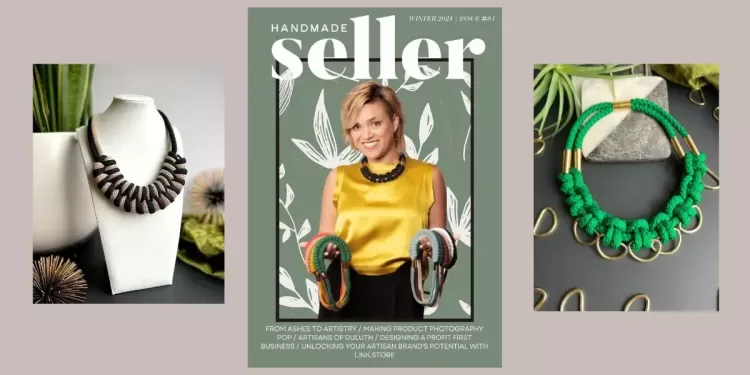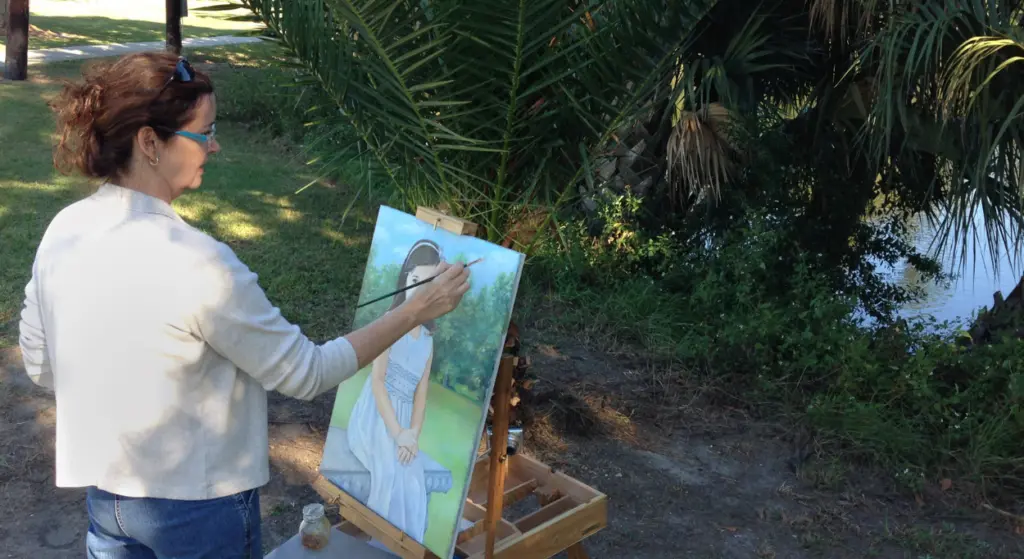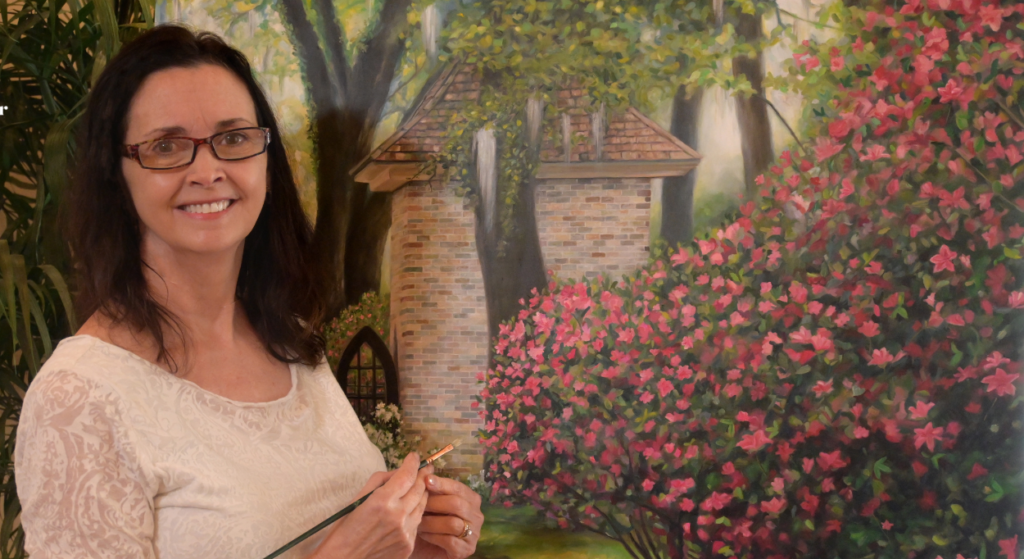Discovering Identity as an Artist
I’ve had many struggles over the years but the first big step for my life was accepting that I am an artist. Growing up in New Orleans, Louisiana, I was intrigued by the charm of the old city and fascinated by the style and character of the antiques in my (adopted) father and grandfather’s antique gallery. That is where I developed my love for art.
I began painting as early as three years old. As a young girl, I would go to my grandfather’s antique shop all the time. I could spend countless hours studying carved wood, marble, old paintings, and etchings. I was so intrigued by the incredible workmanship of people from so long ago. I wanted to understand every technique, every curve and brush stroke; and I wanted to learn how to make art just as beautiful as the art that I saw around my grandfather’s antique shop. Although I don’t remember the story, my mother always said that the very first time I had some money of my own, I told her, “Mommy, I really need to go buy some paint and brushes.”

I was given up for adoption by a woman during the hippie years and for a long time that was just about all I knew about her. I spent much of my life feeling out of place, like I was always searching for something that was missing in me. As a young child, I was very different from my adopted family. I dearly loved them, but I often felt like a square peg trying to cram myself into a round hole. I was picked on for being “different.” I was called “unique,” but at the time this label was given as a criticism, rather than as the accolade it truly is.
When I grew older that searching feeling led me down a long path to find my birth mom and biological family. When I finally found my family, I learned that my birth mother was an artist too. Once I found out that the artsy side of me was a part of me, in my blood and in my bones, I didn’t feel I had to fight it anymore. This realization allowed me to accept my love for art and I was finally able to dive full force into creating.

The Journey Begins
While my children were still young, I started illustrating books for a group I had worked for since living in Dallas. The flexible schedule of working from home was great because it was important for me to be there for my children. I did book illustrations for years, mostly educational books. Most of the drawings were old-school hardcopy drawings, black and white (and kind of boring). When the educational series was coming to an end I started thinking about doing fine art. I knew of a local gallery that was a hot spot for art collectors and wondered if I could find a place there.
Once my kids got older, I decided to take the leap and work at starting my own business. I began with anything creative: photography jobs, graphic design work, illustration, and fine artwork. But I was quickly wearing myself too thin with all the projects. So, I decided to focus only on fine art paintings, decorative prints, and portrait commissions. Narrowing my focus allowed me to develop my skill more specifically in the work that I most enjoyed and to specialize my name and brand. Over the years I developed my style and turned my focus to creating hand-rendered oil portraits and decorative fine art paintings. It’s pretty much traditional realism with little hints of impressionism at times.
Sad to say, but it took me almost two years to get the courage to present my work to my first gallery. When I finally did, they immediately started selling my work and I soon made the drive to the state office to do the necessary paperwork to become a business.
Shortly after that, I had a meeting with a small business advisory office. I went to them under the advice that they could give anyone a detailed business plan for any kind of business. They told me they would let me know the capital I’d need, how much money should be set aside for advertising, supplies, business expenses, everything. Then, they asked what business plan I was interested in? I told them that I’m an artist and received a blank stare back. The man then said, “oh, we don’t have anything to help you.” They really didn’t understand how an artist could run their own business and there weren’t nearly as many resources to help people like me get started at the time.
So, I was just out there trying to figure all this out on my own, with no business degree, only a passion to create. At that time, all I could find were a handful of books. So, to get my business off the ground I went to galleries, browsed through them, and asked myself, am I a good fit for this place? If I thought they would be interested in my work, then I would share my portfolio with them. Nowadays it can be as easy as sending them an email, or showing the gallery director images on your phone.
I am not naturally a business person, but I trusted my skills and knew I could produce great work. But still, making quality art was only the first step to running a business as an artist. An artist also needs to know how to connect with their audience. You have the right tools today to help with this, including utilizing social media and emailing collectors. It’s good to keep reminding people who you are and what it is that you do. And you can use social media to do that. Make sure you’re getting out there and talking to people. That has always been way more difficult than creating for me, and I think it is for many artists, but it’s really important to talk to people to grow your business.
A good way to handle a large amount of work is to make daily goals. If that’s too challenging, then create weekly and monthly goals. Spend a portion of your time creating, but make yourself spend just as much time doing the more daunting things like paperwork, gallery visits, and shows.
Starting is Can Be Hard but It Gets Better
When I started showing my work in galleries I was initially very intimidated. There were all of these amazing artists that I imagined on pedestals way above me in positions that I could never attain. I eventually became friends with one of the top artists at the first local gallery I got into. I remember visiting with him one day and a comment he made really impacted me. As we were talking about showing our works, meeting buyers, and the prices of our art, he said to me, “I can’t even afford my own art.” He laughed it off, of course, but it made me think to myself, wow, he’s just a regular guy. I’m really not so different. Him saying that helped me to see how all artists are kind of in the same boat, how we go through the same things, and how we can support each other. This gave me the confidence I needed to keep on trying, and suddenly everything seemed a lot less intimidating.
Since that time, I’ve had many galleries representing me. I sell online and create custom pieces for homes and businesses. When I’m not working on commissioned pieces, I paint for galleries. Sometimes, I get a unique project like artwork for a hospital or university. I enjoy painting portraits so much because they are a way to honor the individual depicted. Giving a portrait as a gift is one of the most meaningful and personal gifts you can give. Knowing that someone is valued so much as to be honored with such a painting is really rewarding for me. And I always feel incredibly honored that I am the artist chosen for such a project.
Use Every Opportunity
After meandering on this artsy course for a very long time, I now feel hyper-focused on the path I should follow at this point in my life. I attend workshops, watch online tutorials, and constantly try to attain more knowledge. I am ever asking myself:
- Is there something specific I need to work on to get to the next level?
- How am I doing in my artistic growth?
- What can I do to improve my skill?
Having my own business has challenges. I’m in charge of inventory, advertising, social media integrations, email marketing, bookkeeping, managing websites and shipments, contract negotiations, and yes, creating art too. I wear so many hats running my business, and not all are the perfect fit, but that’s okay!
If you’re an artist early in your career, I’d encourage you to do a residency and find a mentor to walk you through this. Having someone who has done it before you, who can support your journey is immeasurably valuable. If you are fortunate enough to get an excellent education, do it. If you have the support and encouragement of your parents and family, it is a blessing, never take that for granted.
You’ll have to be good at multitasking. Having organizational skills and people skills are a must. Thankfully, today there are online classes, courses, magazines like this one, and more to help creatives explore the possibilities out there with plenty of practical advice. These online communities, forums, and publications will ensure that you are not alone. To be honest, it may be challenging. I know I’ve hit many bumps along the way. But with determination, and hopefully a strong support system, you can do it!
Artistry is a journey that is ongoing in many ways. In spite of the challenges, you’ll find that it changes you, builds you up, along the way. When I started my journey as an artist I felt isolated and abandoned. Now, after doing this for many years, I find myself so proud of my accomplishments and focused on improving my skill for my future works.

Interested in a subscription to the magazine?
Interested in a digital or print subscription to our quarterly magazine? Or are you interested in reading back issues of the magazine?










